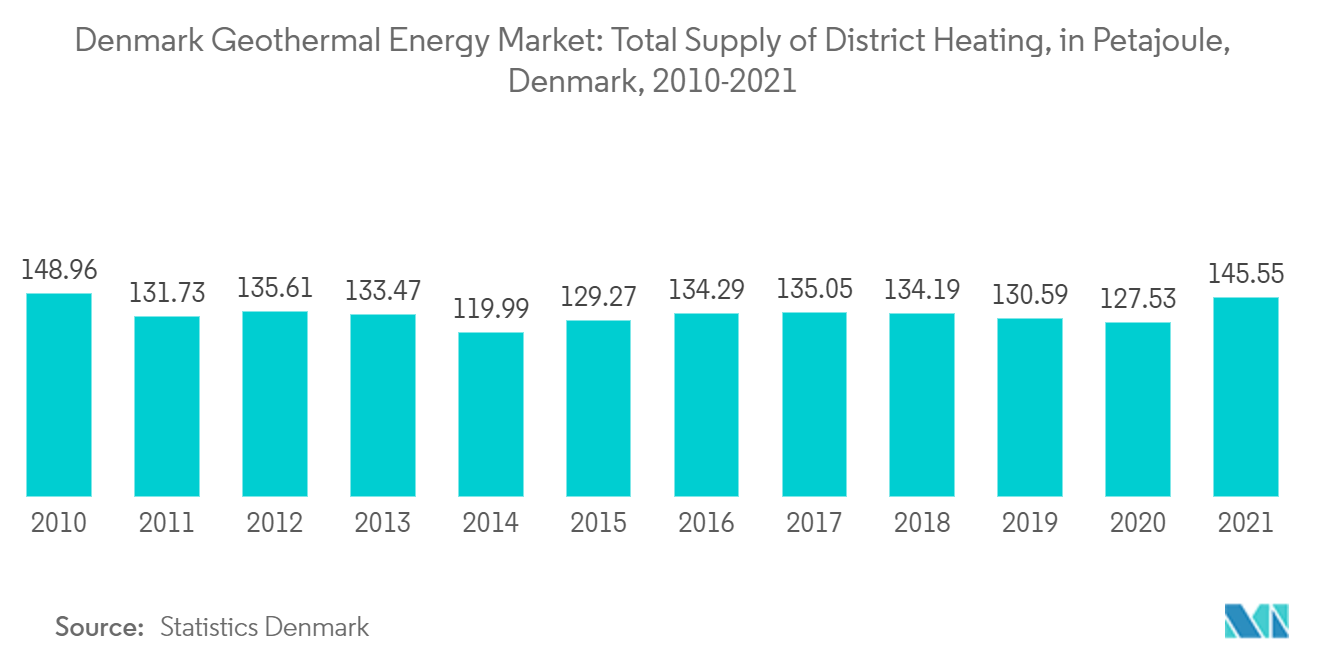Market Trends of Denmark Geothermal Energy Industry
This section covers the major market trends shaping the Denmark Geothermal Energy Market according to our research experts:
Direct Heat Utilization is Expected to Drive the Market
- Denmark has moderate temperature gradients, but widespread geothermal aquifers and district heating networks in most of the Danish towns supply heat to approximately 60% of Danish households. The supply of district heating in Denmark increased significantly in 2021, reaching 145.55 petajoules.
- Geothermal energy is a renewable energy source with vast potential. It carries the benefits of low CO2 emissions, low running costs, local production, and high security of supply. And after investments, it has a long life. The geothermal reserves in the Copenhagen area in Denmark could cover 30-50% of the area's district heating needs for the next several thousand years.
- In Denmark, low-temperature geothermal heat is used in district heating as one of many energy sources. The technology utilizes energy obtained from porous sandstone beneath some Danish cities. There are three geothermal plants in operation in Denmark. They are based in Thisted, Sønderborg and Amager (Copenhagen). In addition, a number of licenses have been granted to explore the opportunities for using geothermal energy in certain areas.
- There is great potential for geothermal energy in Greater Copenhagen, and there is a broad consensus that geothermal energy will play a role in the green heat supply of the future.
- The deeper geothermal resources in Denmark relate to two deep sedimentary basins: the Danish Basin (including the Sorgenfrei-Tornquist Zone and the Skagerrak-Kattegat Platform) and the North German Basin. In Denmark, shallow Geothermal Energy is commonly described as Ground Source Heating and Cooling, which covers horizontal collectors, borehole heat exchangers (vertical or inclined), and groundwater-based open loop systems.
- In January 2022, A.P. Moller Holding subsidiary Innargi signed a 30-year agreement with the City of Aarhus to develop and operate the largest geothermal heating plant in the EU.
- Hence, with the increasing demand for energy and the potential of untapped geothermal resources, the demand for geothermal energy technologies is expected to increase during the forecast period.

Increasing Wind Energy Deployment is Likely to Hinder the Market Growth
- During the period from 2009 to 2021, Denmark's total geothermal energy consumption decreased significantly. During the first two years, geothermal energy consumption was higher, peaking at 483 terajoules in 2009. In 2021, consumption had reached 53.7 terajoules.
- Among all the renewable power generation advances accessible in the country, the wind has shown potential development, pulling in significant government spending. The policy landscape of governments and associations is focused basically on wind energy resources.
- Wind energy plays a central role in Denmark's ambitious goal to remove fossil fuels from all electricity generation. Denmark's location plays a pivotal role in its production of onshore and offshore wind, given that it experiences strong winds coming from the North Sea and the Baltic Sea.
- In Denmark, the wind energy source is dominating the renewable energy mix in 2021 and is expected to continue dominating in the forecast period. This is because of the declining cost of the technology and the expanded adoption of wind energy by various sectors in the country. Wind accounted for 43.6% of Denmark's power usage in 2021 and the installed wind capacity has reached 7,178 MW.
- Denmark is considering adding an additional 4 GW of offshore wind capacity by the end of the decade, increasing the target for 2030 from 8.9 GW to 12.9 GW. In 2030, Denmark would produce 49.5 TWh of electricity from offshore wind.
- Hence, the increasing growth of wind energy is likely to hinder the geothermal energy market during the forecast period.


